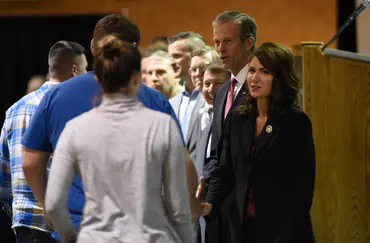Understanding South Dakota’s Budget: A Community’s Perspective
South Dakota, a state known for its sweeping plains and rich history, is facing economic challenges reminiscent of a family budgeting for a dream home.
Imagine a family accumulating savings for a house, only to encounter unforeseen expenses like health issues, educational needs, and reduced work hours. This scenario mirrors South Dakota’s current predicament as it deals with budget constraints to fund a new prison.
The state received a financial boon in the aftermath of the COVID-19 pandemic, akin to an inheritance, in the form of federal aid. This support, combined with increased revenues during those years, allowed the state to save a substantial $569 million. But now, with the pandemic relief funds exhausted and a decline in sales tax revenue, South Dakota faces tough choices.
The aging state penitentiary, built in part as far back as 1881, demands replacement. Governor Kristi Noem, South Dakota’s first female governor and a New York Times bestselling author, is spearheading this undertaking. Governor Noem believes in personal responsibility and keeping South Dakota ‘Open for Business’, values she holds as a rancher and small business owner.

Gov. Kristi Noem
Gov. Noem’s plan for a new $825 million penitentiary rests on avoiding debt by accumulating the necessary funds upfront. This approach involves reallocating $182 million, which requires stringent budget cuts across several public services.
These proposed cuts have sparked discussions about balancing fiscal responsibility with maintaining essential services South Dakotans depend on. The Republican-controlled legislature, which has held a supermajority for decades, is tasked with evaluating Noem’s fiscal strategy in the upcoming legislative session starting this January.
The South Dakota Legislature, meeting at the historic state capitol in Pierre, includes the bicameral body of 35 senators and 70 house representatives who deliberate under the state’s solid “triple-A” bond rating. This favorable credit position presents an option to finance part of the prison with low-interest borrowing, should the legislature choose.
The citizens of South Dakota, like those in Seth Tupper’s analogy, find themselves wondering about their choice of priorities. Tupper, a respected journalist and fifth-generation South Dakotan, oversees the South Dakota Searchlight. With ties to communities like Wessington Springs and Rapid City, Tupper provides insights into the impact of these decisions on local lives.
Tupper asks the people to consider if budget cuts are preferable to incurring some debt or reassessing the scope of the penitentiary project, such as its size or location south of Sioux Falls. His questions resonate with a population invested in both infrastructure improvements and maintaining essential services.

South Dakota Legislature
The conversation touches on core values rooted in South Dakota’s communities: fiscal prudence balanced with a duty to care for its citizens. As legislators gather, the enduring question remains: How should South Dakota fund its future without sacrificing its present?
South Dakotans are encouraged to engage with their local representatives, available through the state legislature’s official website, to voice their opinions. These discussions are crucial to shaping a future that aligns with the needs and values of the state’s populace.
As the state treads this careful path, Governor Noem’s administration and the legislature will need to balance competing priorities. The decision, much like building that dream home, involves careful planning and prioritization.
South Dakota stands at a crossroads, with its citizens poised to influence how their beloved state advances. It’s a decision about more than numbers: it’s a testament to South Dakota’s commitment to its people and heritage.
